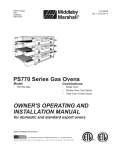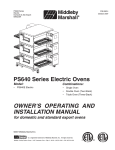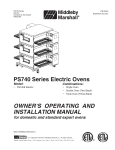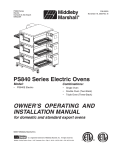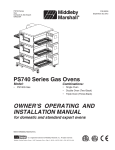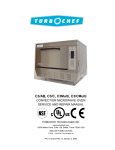Download Middleby Marshall PS870 Series Installation manual
Transcript
PS870 Series Gas Domestic ENGLISH P/N 59157 August 4, 2006 PS870 Series Gas Ovens Model: Combinations: • • • • PS870G Gas Single Oven Double Oven (Two-Stack) Triple Oven (Three-Stack) OWNER'S OPERATING AND INSTALLATION MANUAL for domestic and standard export ovens ©2006 Middleby Marshall Inc. is a registered trademark of Middleby Marshall, Inc. All rights reserved. Middleby Cooking Systems Group • 1400 Toastmaster Drive • Elgin, IL 60120 • (847)741-3300 • FAX (847)741-4406 2 Model No. Modéle No. Serial No. Serié No. Installation Date Date d'installation MIDDLEBY MARSHALL NO QUIBBLE LIMITED WARRANTY (U.S.A. ONLY) MIDDLEBY MARSHALL INC. OVEN LIMITED WARRANTY (Non U.S.A.) The Seller warrants equipment manufactured by it to be free from defects in material and workmanship for which it is responsible. The Seller’s obligation under this warranty shall be limited to replacing or repairing, at Seller’s option, without charge, F.O.B. Seller’s factory, any part found to be defective and any labor and material expense incurred by Seller in repairing or replacing such part. Such warranty is limited to a period of one year from date of original installation or 15 months from date of shipment from Seller’s factory, whichever is earlier, provided that terms of payment have been fully met. All labor shall be performed during regular working hours. Overtime premium will be charged to the Buyer. MIDDLEBY MARSHALL, HEREINAFTER REFERRED TO AS “THE SELLER”, WARRANTS EQUIPMENT MANUFACTURED BY IT TO BE FREE FROM DEFECTS IN MATERIAL AND WORKMANSHIP FOR WHICH IT IS RESPONSIBLE. THE SELLER’S OBLIGATION UNDER THIS WARRANTY SHALL BE LIMITED TO REPLACING OR REPAIRING, AT SELLER’S OPTION, WITHOUT CHARGE, ANY PART FOUND TO BE DEFECTIVE AND ANY LABOR AND MATERIAL EXPENSE INCURRED BY SELLER IN REPAIRING OR REPLACING SUCH PART. SUCH WARRANTY SHALL BE LIMITED TO THE ORIGINAL PURCHASER ONLY AND SHALL BE EFFECTIVE FOR A PERIOD OF ONE YEAR FROM DATE OF ORIGINAL INSTALLATION, OR 18 MONTHS FROM DATE OF PURCHASE, WHICHEVER IS EARLIER, PROVIDED THAT TERMS OF PAYMENT HAVE BEEN FULLY MET. This warranty is not valid unless equipment is installed, started, and demonstrated under the supervision of a factory-authorized installer. Normal maintenance functions, including lubrication, adjustment of airflow, thermostats, door mechanisms, microswitches, burners and pilot burners, and replacement of light bulbs, fuses and indicating lights, are not covered by warranty. This warranty is valid only if the equipment is installed, started, and demonstrated under the supervision of a factory-authorized installer. Any repairs or replacements of defective parts shall be performed by Seller’s authorized service personnel. Seller shall not be responsible for any costs incurred if the work is performed by other than Seller’s authorized service personnel. Normal maintenance functions, including lubrication, cleaning, or customer abuse, are not covered by this no quibble warranty. When returning any part under warranty, the part must be intact and complete, without evidence of misuse or abuse, freight prepaid. Seller shall be responsible only for repairs or replacements of defective parts performed by Seller’s authorized service personnel. Authorized service agencies are located in principal cities throughout the contiguous United States, Alaska, and Hawaii. This warranty is valid in the 50 United States and is void elsewhere unless the product is purchased through Middleby International with warranty included. Seller shall not be liable for consequential damages of any kind which occur during the course of installation of equipment, or which result from the use or misuse by Buyer, its employees or others of the equipment supplied hereunder, and Buyer’s sole and exclusive remedy against Seller for any breach of the foregoing warranty or otherwise shall be for the repair or replacement of the equipment or parts thereof affected by such breach. The foregoing warranty is exclusive and in lieu of all other warranties, expressed or implied. There are no implied warranties of merchantability or of fitness for a particular purpose. The foregoing warranty shall be valid and binding upon Seller if and only if Buyer loads, operates and maintains the equipment supplied hereunder in accordance with the instruction manual provided to Buyer. Seller does not guarantee the process of manufacture by Buyer or the quality of product to be produced by the equipment supplied hereunder and Seller shall not be liable for any prospective or lost profits of Buyer. The foregoing shall be Seller’s sole and exclusive obligation and Buyer’s sole and exclusive remedy for any action, including breach of contract or negligence. In no event shall Seller be liable for a sum in excess of the purchase price of the item. Seller shall not be liable for any prospective or lost profits of Buyer. THE FOREGOING WARRANTY IS EXCLUSIVE AND IN LIEU OF ALL OTHER EXPRESS AND IMPLIED WARRANTIES WHATSOEVER. SPECIFICALLY THERE ARE NO IMPLIED WARRANTIES OF MERCHANTABILITY OR OF FITNESS FOR A PARTICULAR PURPOSE. This warranty is effective on Middleby Marshall equipment sold on, or after, February 15, 1995. The foregoing shall be Seller’s sole and exclusive obligation and Buyer’s sole and exclusive remedy for any action, whether in breach of contract or negligence. In no event shall seller be liable for a sum in excess of the purchase price of the item. © 2003 - Middleby Marshall, A Middleby Company. The Middleby Marshall logo is a registered trademark of Middleby Marshall, A Middleby Company. Middleby Marshall Inc. • 1400 Toastmaster Drive • Elgin, Illinois 60120-9272 U.S.A. • (847) 741-3300 • FAX: (847) 741 4406 3 Table of Contents Page Page SECTION 1 IV. ASSEMBLY ...................................................................... 9 DESCRIPTION .................................................................... 5 A. Base Pad, Legs, Casters, and Stacking .................. 9 I. OVEN USES .................................................................... 5 B. Restraint Cable Installation ...................................... 9 II. OVEN COMPONENTS .................................................... 5 C. Conveyor Installation ................................................ 9 A. Conveyor Motor Drive .............................................. 5 D. Standoff Installation ................................................ 10 B. Crumb Pans ............................................................... 5 V. FINAL ASSEMBLY ....................................................... 11 C. Conveyor End Stop and Rear Stop .......................... 5 VI. ELECTRICAL SUPPLY ............................................... 11 D. Conveyor End Stop and Rear Stop .......................... 5 Connection .................................................................. 12 E. Conveyor .................................................................... 5 VII. GAS SUPPLY ............................................................. 12 F. End Plugs .................................................................... 5 A. Gas Utility Rough-In Recommendations ............... 12 G. Eyebrows ................................................................... 5 B. Connection ............................................................... 13 H. Window ....................................................................... 5 C. Gas Conversion ....................................................... 13 I. Machinery Compartment Access Panel ................... 5 D. Propane Conversion ............................................... 13 J. Serial Plate ................................................................. 5 SECTION 3 K. Control Panel ............................................................. 5 OPERATION ........................................................................ 14 L. Gas Burner ................................................................. 5 I. LOCATION AND DESCRIPTION OF CONTROLS ....... 14 M. Blowers ...................................................................... 5 II. NORMAL OPERATION, STEP-BY-STEP ..................... 15 N. Air Fingers ................................................................. 5 A. Main Screen ............................................................. 15 III. OVEN SPECIFICATIONS ................................................. 5 A. Daily Startup Procedure ......................................... 16 A. Dimensions ................................................................ 5 B. Daily Shutdown Procedure ..................................... 16 B. General Specifications ............................................. 5 III. QUICK REFERENCE: TROUBLESHOOTING ......... 17 C. Electrical Specifications for PS870 Gas Ovens ..... 6 IV. SCREEN ALERTS ................................................... 17 D. Gas Orifice and Pressure Specifications for PS870 Gas Ovens .............................................. 6 SECTION 4 MAINTENANCE .................................................................. 18 SECTION 2 INSTALLATION .................................................................. 6 I. MAINTENANCE - DAILY .............................................. 18 I. BASE PAD KIT ............................................................... 7 II. MAINTENANCE - MONTHLY ....................................... 19 II. INSTALLATION KIT ........................................................ 8 III. MAINTENANCE - EVERY 3 MONTHS ........................ 20 III.VENTILATION SYSTEM ................................................. 8 IV. MAINTENANCE - EVERY 6 MONTHS ....................... 21 A. Requirements ............................................................ 8 V. KEY SPARE PARTS KIT ............................................. 22 B. Recommendations .................................................... 8 SECTION 5 C. Other Ventilation Concerns ...................................... 8 ELECTRICAL WIRING DIAGRAM ...................................... 23 I. WIRING DIAGRAM, 870 GAS OVEN, 208/240V, 50/60 Hz, 1 Ph ............................................................... 23 4 5 6 7 ITEM 1 2 3 4 5 6 7 8 9 10 11 12 QTY 1 1 1 P/N 55028 55027 59026 1 1 1 1 1 1 1 2 2 42612 33120-0056 22450-0130 59155 59099 59098 59226 48522 19A15144 DESCRIPTION STOP,BACK SIDE CONV EXT STOP,SIDE END CONV EXT OWNER'S OPERATING & INSTALLATION MANUAL KIT,SUPPLEMENT SVC AGENCY LIST PIPE,BLK 1-1/4" X 54" BAG,POLY4MIL 9" X 12"W/MINI-GRIP BUSHING,HEYCO SB 1500-18 Reflector Bracket, Reflector WLDMT, Bracket Reflector Spacer, 1.5" Dia X 1.125" H SCR, MS HH 10-32 X 1-1/4 18-8 8 9 D. STANDOFF INSTALLATION 1 Place screw, P/N 19A15144, through counter-bored hole in standoff, P/N 48522, and screw into weld nut on rear shroud. 2. Repeat procedure for both sides. 10 Mount the new reflector bracket to the provided holes on the front right-hand side of the oven. The reflector should be positioned just above the conveyor belt. Using an assistant, hold both back cover switches in the closed position. This will allow power to the photo-eye, and it will provide a red beam for aiming. Loosen one of the screws holding the photo detector gimbal tight, allowing it to be reaimed at the reflector. The beam should hit exactly in the center of the reflector, then tighten the screw back down. Note: This is MUCH easier in reduced light. Replace all covers. CONVEYOR BELT REVERSAL Conveyor belt reversal consists of four steps: 1. Physically reversing the conveyor belt. 2. Moving the lower thermocouple. 3. Resetting direction jumper on the conveyor control board. 4. Switching the photo detector. REVERSING THE CONVEYOR BELT Remove the conveyor from the oven and find the master link location. Remove master links and remove the belt from the conveyor frame. Reassemble the belt back onto the frame (in the reverse direction) and reinstall the master links. Replace the conveyor assembly in the oven. MOVING THE LOWER THERMOCOUPLE The lower thermocouple needs to be moved from the lower outer most hole to the opposite side lower outer most hole. The thermocouple electrical connection needs to be moved as well. Insert the thermocouple (TC2) into the thermocouple hole left open by the removal of the coverplate. Secure the thermocouple (TC2 and rename TC3) with the two (2) 6-32 screws that were removed previously. Secure the coverplate with the two (2) 6-32 screws over the hole where the thermocouple (TC2) was removed. RESETTING DIRECTION JUMPER Incoming electrical power lines are fed through the strainrelief fitting, shown in Figure 2-12. The electrical supply connections are made inside the electrical junction box. The power lines then connect to the oven circuits through safety switches located inside the machinery compartment and each blower motor compartment. These switches interrupt electrical power to the oven when the Machinery Compartment Access Panel is opened, OR when either of the blower or rear shrouds is removed. Locate Jumper P1 on the conveyor control board. Move jumper from terminals 1 and 2, and replace onto terminals 2 and 3. SWITCHING PHOTO DETECTOR Remove both rear fan belt covers, then remove the motor cover assembly from both sides of the oven. The photo eye is located on the front side of the left motor bracket. Disconnect the three connecting wires, noting which color wires assemble to the associated wires on the photo-detector. Remove the entire photo detector bracket. Replace the assembly to the righthand side of the unit, mirroring the way it was assembled on the left. Reconnect the detector wiring in the same order it was on the left. 11 Connection Refer to the wiring diagram inside the machinery compartment of the oven to determine the correct connections for the electrical supply lines. Connect the supply as indicated on the wiring diagram. CAUTION The terms of the oven's warranty require all start-ups, conversions and service work to be performed by a Middleby Marshall Authorized Service Agent. 12 D. PS870 Propane conversion Four items have to be changed, to change the oven to LP: 1. Adjust internal burner air shutters. 2. Replace main Orifices 3. Replace (and adjust) the spring in the main valve (see LP kit) 4. Adjust modulating valve bypass settings. Disconnect the manifold unions closest to the main burner, and remove the manifold assemblies (four screws each). Remove the addition four screws holding the burner cores and slide out each burner core (leaving the ignition and sense wires connected). Adjust the internal air shutters fully open, and replace the cores. Replace the main orifices on the manifold assemblies with the LP units, and replace the manifold assemblies. Reconnect the unions. Replace the valve spring with the LP spring, and adjust the downstream pressure to get 7″ WC. Adjust the bypass screws in the side of each modulating valve to approximately 1/6 turn from fully closed. If this setting is too low, the burners will shut off when trying to modulate. If it is too open, the unit will tend to gradually raise up in temperature at standby. Certain safety code requirements exist for the installation of gas ovens; refer to the beginning of Section 2 for a list of the installation standards. In addition, because a the oven is equipped with casters, the gas line connection shall be made with a connector that complies with the Standard for Connectors for Movable Gas Appliances, ANSI Z21.69 (in U.S.A.), as well as a quick-disconnect device that complies with the Standard for Quick-Disconnect Devices for Use With Gas Fuel, ANSI Z21.41 (in U.S.A.). Figure 2-14 - Gas Burner/Blower Motor and Piping Assembly Burner/Blower Motor Gas Burner 13 SECTION 3 - OPERATION C. Temperature Control Display E. Message Bar Increase Decrease A. Main On/Off Button B. Conveyor Time Setting D. TEMP Set Right Left LOCATION AND DESCRIPTION OF CONTROLS C. Temperature Control/Display Displays the set point of both right and left sides of the oven. D. TEMP Set Pressing on the “TEMP” button shows individual displays and combined adjustments. E. Message Bar Indicates various messages pertaining to current oven conditions. A. Main On/Off Button Turns all oven functions on or off. If the oven is below the set point, it will rise to the set point and turn the conveyor on. If it is turned off and the oven is above 200° F, the blowers will remain on until the oven drops below 200° F. B. Conveyor Time Setting Adjusts and displays the conveyor bake time. Dual belt ovens have two displays, single units have one. 14 NORMAL OPERATION - STEP-BY-STEP2. Push the “ON/OFF” button to start the oven. The controller will display the screen, as shown in Figure 3-3. A. Main Screen 1. When the unit has been “OFF” for more than 1 minute the controller will display the screen saver, as shown in Figure 3-1. To start operation, push the “Enter/ Reset” button. The controller will display the “OFF” screen, as shown in Figure 3-2. ON/OFF button Figure 3-3 Main Screen ON Figure 3-1 Screen Saver 3. To change the temperature, push the “TEMP” button. The controller will display the screen, shown in Figure 3-4. To change the left temperature, push the ←” arrow button. Then push either the “↑” arrow or “↓” “← arrow buttons to increase or decrease temperatures respectively. To change the right temperature, push the “→” arrow button. Then push either the “↑” arrow or “↓” arrow buttons to increase or decrease temperatures accordingly. When the proper temperatures are entered, push the “Enter/Reset” button. The controller will now show the display shown in Figure 3-3. Figure 3-2 Main Screen OFF TEMP Set button Figure 3-4 Temperature Screen 15 4. To change the conveyor belt speed, push the “TIME” button. The controller will display the screen, shown in ←” Figure 3-5. To change the minute setting, push the “← arrow button. Then push either the “↑” arrow or “↓” arrow buttons to increase or decrease the time accordingly. To change the second setting, push the “→” arrow button. Then push either the “↑” arrow or “↓” arrow buttons to increase or decrease the time accordingly. When the proper times are entered, push the “ENTER/RESET” button. The controller will now show the display shown in Figure 3-3. Message Bar ON/OFF button C. Daily Shutdown Procedure 1. Make certain there are no products left on the conveyor in the oven. 2. Press the “ON/OFF” button to turn the oven off. 3. Open the window to allow the oven to cool faster. 4. After the oven has cooled and the blowers have turned off, the circuit breaker/fused disconnect may be turned off. Quick Reference – Touch Screen Controller A. Main Screen 1. ON/OFF button - Used to turn oven On and Off. 2. TIME - See Separate Instructions. 3. TEMP - See Separate Instructions. 4. Energy level indicators - Indicators to either side of the screen indicate the energy input to that side of the oven. 5. Message bar - Indicates various messages pertaining to current oven conditions. B. Oven Temperature/Set Point/Indicator Screen 1. Right actual temperature - Indicates current average temperature of the right side of the oven. 2. Left actual temperature - Indicates current average temperature of the left side of the oven. 3. Set point temperature - Pressing on this value allows the user to adjust the set point of the oven. 4. Exit - Returns to the main screen. C. Energy Modes Energy Mode One - This mode is automatic, and starts (bake time +1 minute) after the last product has entered the oven. In this mode, the main oven blowers will lower to 1500 RPM, while the oven maintains temperature and belt speed. Energy Level Indicators TEMP button TIME button Figure 3-5 Belt Speed Screen B. Daily Startup Procedure 1. Check that the circuit breaker/fused disconnect is in the On position. Check that the window is closed. The touch panel display should be lit. 2. Adjust the conveyor to the desired bake time. 3. Press the temperature button to display right and left hand oven settings. Set temperatures as desired. 4. Press the “ON” button to activate the oven. The conveyor will not run, until the oven temperature has reached the set points. 16 III. QUICK REFERENCE: TROUBLESHOOTING SYMPTOM PROBLEM SOLUTION Oven will not turn On. No electrical power • Check that the circuit breaker/fused disconnect is on. Make sure the emergenct stop button is on. Oven will not heat. No gas pressure • Make sure main gas is on. Burner did not light • Turn oven off, and restart. If it still does not light, call for service. Oven is operating, but little or no air is coming from the fingers. Air fingers may be assembled incorrectly after cleaning. • Turn oven off, and allow to cool. Reassemble fingers correctly. Conveyor will not move. Oven is not up to operating temperature. • Allow oven to preheat. Conveyor may be jammed. • Turn oven off, and allow to cool. Check conveyor for blockage. IV. SCREEN ALERTS SYMPTOM PROBLEM Battery Symbol in the lower right hand corner The internal battery needs to be replaced to retain energy mode timings. • A qualified service technician should accomplish this. High Control Compartment Temperature Clean and replace the front fan filters. • Failure to do this will eventually shut down the oven due to excessive temperature. Main Blower problem or Combustion Blower problem. The computer has detected a problem with either the main, or burner blowers. • This should be corrected by a qualified service technician. Control Over Temp Front filters are clogged • Clean or replace filters. Front belt jammed Front belt has stopped • • Remove obstruction, and restart oven. If no obstruction, call service. Rear Belt jammed Rear belt has stopped • • Remove obstruction, and restart oven. If no obstruction, call service. High Temp Error Thermocouple or PLC malfunction • Call service Belt off-Oven not in temperature Normal operation until Oven reaches operating temperature Energy Saving Mode 1 Normal operation Energy saving mode 2 Normal Operation Energy saving Mode 3 Normal operation SOLUTION 17 18 19 20 E. Blower Belts 1. To gain access to each blower belt compartment remove the four screws shown in Figure 4-8. Then, lift the rear shroud off its hangers. If access to the blower motors is required, remove the three mounting screws (two on the front of each shroud and one on the rear). Then, lift the end shroud straight up and off its hangers. 2. Check each blower belt for cracking or excessive wear. 3. Check for amount of belt deflection in the center of the belt, 1/2″ deflection is acceptable, see Figure 4-9. 4. If necessary, replace belt. IV. MAINTENANCE - EVERY 6 MONTHS A. Check that the oven is cool and the power is disconnected as described in the warning at the beginning of this Section. B. For gas ovens, clean and inspect the burner nozzel and electrode assembly. C. Check (and clean, if necessary) the oven venting system. D. Check the conveyor drive shaft bushings and spacers. Replace the components if they are worn. Figure 4-9 - Belt Deflection 21 ITEM QTY. 1 P/N DESCRIPTION 1 1 59081 DIGITAL DISPLAY, PROGRAMMED 2 1 58678 MOTOR, CONVEYOR DRIVE 3 1 58679 CONVEYOR CONTROL BOARD 4 2 59168 INVERTER, PROGRAMMED 5 1 M9608 POWER SUPPLY 6 1 59337 KIT, THERMOCOUPLE (6 THERMOCOUPLES) 7 2 M9616 FAN, COOLING 8 2 57288 MOTOR, BLOWER 9A 1 57141 AIR SWITCH BURNER/BLOWER MOTOR AIR SWITCH MAIN BLOWER 9B 2 50610 10 1 54727 IGNITION MODULE 11 1 M9887 ASSEMBLY, BURNER BLOWER/MOTOR 12 2 41647 VALVE, MODULATING GAS, 1/2" 13 2 31651 AMPLIFIER, MODULATING VALVE 14 1 33983 HIGH LIMIT CONTROL MODULE, 240V 15 2 32108 TRANSFORMER, 240Vp:24Vs 16 1 59109 PLC MODULE, PROGRAMMED 17 1 58668 THERMOCOUPLE MODULE 18 1 58669 CURRENT MODULE 19 1 59112 PHOTOCELL 2 3 4 5 10 15 16, 17, 18 19 Middleby-Marshall Model Number G208-240 volt 50/60 Hz, 1 Phase 54745 Rev. I Wiring Diagrams (electrical schematics) 24

























